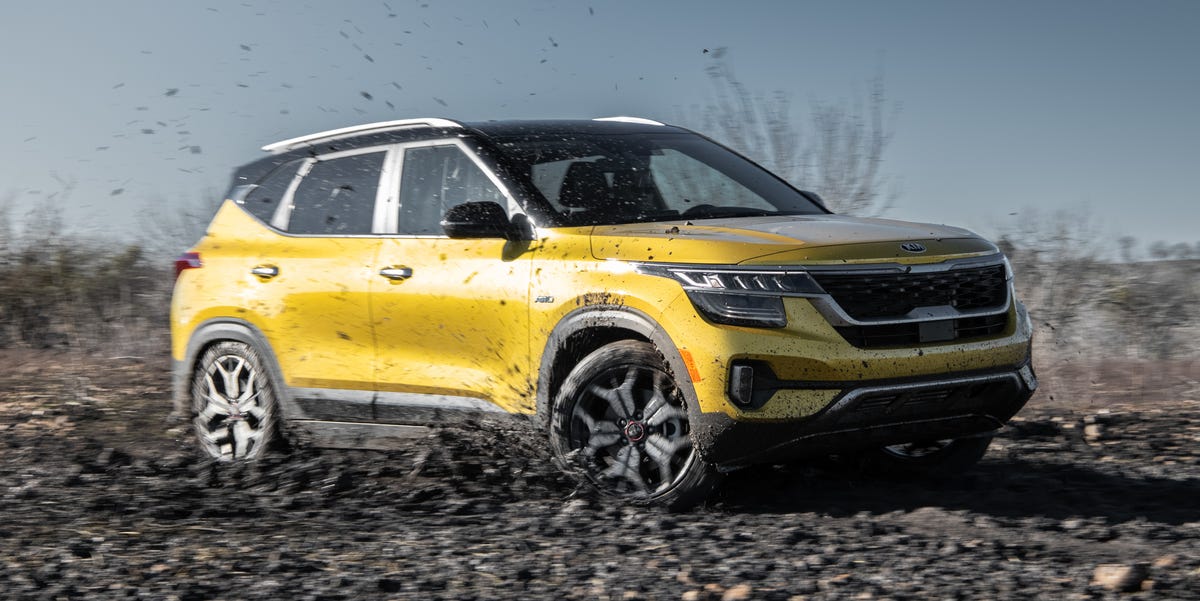
There’s a goodness that Kia has figured out how to bake into its newer SUVs, most notably its mid-size three-row Telluride. While the Korean brand’s latest box on wheels, the new 2021 Seltos, may be tough to classify—it sits right on the subcompact/compact border—it’s apparent after just a few minutes behind the wheel that it shares some of the Telluride’s class-climbing excellence.
We’ve already driven a Korean-market Seltos in South Korea, but this is our first rodeo on home soil. Here are the basics: The Seltos shares its platform and powertrains with the smaller, subcompact Hyundai Kona. It is both larger and more rugged looking, allowing it to approach the compact SUV space and the likes of the Ford Escape and Toyota RAV4, not to mention Kia’s own Sportage. If you’ve been waiting for Kia to build an all-wheel-drive version of its boxy, front-drive Soul, this is as close as you’re going to get.
Unexpected Refinement
The Seltos’s top-level SX specification that we spent the bulk of our time in comes standard with Hyundai/Kia’s familiar 175-hp turbocharged 1.6-liter inline-four and seven-speed dual-clutch automatic transmission. This powertrain also is available on the mid-range S trim level. A healthy 195 lb-ft of torque—available from just 1500 rpm—gives it plenty of punch for highway merges and passing maneuvers. This engine also is pleasingly quiet at anything except full throttle, where it can sound a bit thrashy. While Kia’s dual-clutch automatic still doesn’t operate as crisply as some examples, it calls little attention to itself and generally does an admirable job of making the most of the 1.6-liter’s output. However, we did notice an occasional clunky shift at stop-and-go speeds. Toggling up through the three driving modes (Normal, Smart, and Sport) heightens the transmission’s responsiveness and willingness to hold on to gears, as well as sharpens the engine’s throttle response and firms up the electrically assisted steering.
The standard powertrain is a 146-hp 2.0-liter four paired with a continuously variable automatic transmission (CVT). We only spent a few miles on urban streets with this setup, but it felt powerful and responsive enough to compete with the Nissan Rogues of the world. It is somewhat noisier and coarser in tone than the 1.6-liter turbo, however, and the CVT’s propensity to hold the engine at one droning RPM does the engine no favors. An all-wheel-drive system with an electronic locking center differential is standard on all trims except for the S model, where it’s a $1500 option. Like the Kona, opting for all-wheel drive brings an independent multilink rear suspension in place of the front-drive version’s simpler rear torsion-beam system.
Let’s get one thing out of the way: The Seltos isn’t a performance SUV, but it exhibits secure composure and admirable refinement for its price point. Its taut suspension offers good body control in corners without compromising ride comfort. The steering is precise, which, combined with brake-based torque vectoring, gives this Kia a surprising bit of agility and control without feeling darty or nervous. Wheel sizes range from 17 to 18 inches. SX models carry a combined EPA fuel-economy estimate of 27 mpg, which is respectable amongst the Seltos’s peers, including the Jeep Compass, Mazda CX-30, and Nissan Rogue Sport. Settle for a 2.0-liter model, and that figure climbs to 29 mpg with all-wheel drive and 31 mpg for front-drivers.
Design Within Reach
Given the industrial boxiness of the Soul below it in Kia’s lineup and the frog-faced Sportage above it, the Seltos’s squared-off and chiseled aesthetic strikes us as handsome. Design touches such as the pattern on the grille and the intricate headlights give it a slightly upscale look. A contrasting white or black roof is a $345 option, although you currently can’t pair that with the optional $700 sunroof due to manufacturing constraints. Kia says it plans to rectify that in the future, and that it may introduce additional Seltos variants down the road. The brand has already shown an off-road–oriented X-Line model in concept form.
Inside, the Seltos has supportive front seats, excellent outward vision, and a reclining rear seat with legroom for six-footers. An adjustable two-tier cargo floor provides a decent 27 cubic feet of space behind the second row, which expands to 63 cubes if you fold down the rear seat backs. While fit and finish are commendable, a glossy sheen to the dashboard and upper door panels, as well as plenty of hard plastics throughout, are evidence of the Seltos’s budget price. But ample soft-touch points and thoughtful detailing across the cockpit work well to enhance the atmosphere. Spring for the optional Bose audio system, and you get sound-connected mood lighting that helps dress up the interior at night.
Kia’s latest infotainment system is crisply rendered and highly intuitive, and is controlled through a standard 8.0-inch touchscreen. An expansive 10.3-incher as seen on the Telluride is optional. Likewise, the standard 3.5-inch display in the instrument cluster can be upgraded to a vivid yet straightforward 7.0-inch unit. Only the top SX Turbo trim level gets all of the Seltos’s active-safety and convenience tech, which encompasses pretty much every mainstream anti-collision gizmo on the market. But many of those systems are standard on all but the base LX model.
Family Values
The low $23,110 entry point for the Kia Seltos—which is the same for a base LX version with all-wheel-drive LX or the higher-spec, front-drive S model—makes our (minor) gripes about it seem trivial. Even the top-spec SX is less than $30K, which is still a good value. While the larger Telluride redefines and breaks out of its segment, the Seltos is an attractive and refined entry in the under-$30,000 small SUV class, even if it’s not a segment-buster like its big brother.
